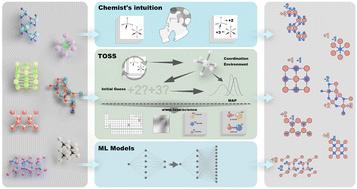Oxidation states in solids from data-driven paradigms
IF 7.4
1区 化学
Q1 CHEMISTRY, MULTIDISCIPLINARY
引用次数: 0
Abstract
The oxidation state (OS) is an essential chemical concept that embodies chemical intuition but cannot be computed with well-defined physical laws. We establish a data-driven paradigm, with its implementation as Tsinghua Oxidation States in Solids (TOSS), to explicitly compute OSs in crystal structures as the emergent properties from large-sized datasets based on Bayesian maximum a posteriori probability (MAP). TOSS employs two looping structures over the large-sized dataset of crystal structures to obtain an emergent library of distance distributions as the foundation for chemically intuitive understanding and then determine the OSs by minimizing a loss function for each structure based on MAP and distance distributions in the whole dataset. We apply TOSS to a dataset of over one million crystal structures, achieving a superior success rate, and use the resulting OS dataset to train a graph convolutional network (GCN) model as an alternative. Both TOSS and the GCN model are benchmarked against a curated ICSD dataset of structures with human-assigned OSs, yielding high accuracies of 96.09% and 97.24%, respectively. We expect TOSS and the ML-model-based alternative to find a wide spectrum of applications, and this work also demonstrates an encouraging example for data-driven paradigms to explicitly compute the chemical intuition for tackling complex problems in chemistry.

基于数据驱动范式的固体氧化态
氧化态(OS)是一个基本的化学概念,它体现了化学直觉,但不能用明确的物理定律来计算。我们建立了一个数据驱动的范式,并将其实现为清华固体氧化态(TOSS),以基于贝叶斯最大后验概率(MAP)明确计算晶体结构中的os作为大型数据集中的紧急属性。TOSS在大型晶体结构数据集上使用两个循环结构,获得一个紧急的距离分布库,作为化学直观理解的基础,然后根据MAP和整个数据集的距离分布,通过最小化每个结构的损失函数来确定os。我们将TOSS应用于超过一百万个晶体结构的数据集,获得了更高的成功率,并使用生成的OS数据集来训练图卷积网络(GCN)模型作为替代方案。TOSS和GCN模型都以人工分配os的ICSD结构数据集为基准,分别获得96.09%和97.24%的高精度。我们希望TOSS和基于ml模型的替代方案能够找到广泛的应用,并且这项工作也为数据驱动范式展示了一个令人鼓舞的例子,可以显式地计算化学直觉,以解决化学中的复杂问题。
本文章由计算机程序翻译,如有差异,请以英文原文为准。
求助全文
约1分钟内获得全文
求助全文
来源期刊

Chemical Science
CHEMISTRY, MULTIDISCIPLINARY-
CiteScore
14.40
自引率
4.80%
发文量
1352
审稿时长
2.1 months
期刊介绍:
Chemical Science is a journal that encompasses various disciplines within the chemical sciences. Its scope includes publishing ground-breaking research with significant implications for its respective field, as well as appealing to a wider audience in related areas. To be considered for publication, articles must showcase innovative and original advances in their field of study and be presented in a manner that is understandable to scientists from diverse backgrounds. However, the journal generally does not publish highly specialized research.
 求助内容:
求助内容: 应助结果提醒方式:
应助结果提醒方式:


